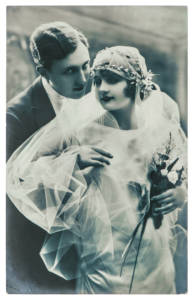Whether it’s an appreciation for retro formalwear, a desire to save money, or both, vintage wedding apparel can be a great option for your upcoming nuptials. At the same time, tracking down fabulous finds requires knowing what you want and observing smart shopping practices. Before you go on the hunt, take a look at these savvy tips.
Top Reasons for Buying Vintage
New designer threads hit the racks every season, but what keeps us coming back to old-school formalwear? In a 2017 Fashionista piece, Fawnia Soo Hoo mentions sustainability as one reason, noting that older garments find new uses rather than being discarded and going to waste. Others are lured by the thrill of donning unique, one-of-a-kind finds and standing out from the pack, particularly in pictures shared on social media. With other soon-to-be-wed folks, vintage attire fits in with larger retro event themes.
Defining Your Era
Keep in mind that words such as “retro” or “vintage” carry subjective meanings and can encompass clothing from almost any decade from the past. Martha Stewart Weddings points out that even 1980s or early 1990s fashions might fall under these categories, so you’re going to need to pin down exactly what type of vintage wear you want. Also, deciding on your affair’s intended look and feel is important, since it can serve as a style guide when you go shopping. Finally, don’t overlook the “revival” trends that have recurred throughout history, such as the comebacks of some 1960s fashions in the early 1990s and a few late 1980s styles working their way back into current trends.
Where To Start
With the wide range of vintage apparel options on the market, it may be hard to decide where to start. You can typically find your garment of choice in several different types of venues:
- Consignment shops
- Online retailers
- Private sellers
- Thrift stores
However, purchasing a secondhand garment can come with one risk: your inability to return the item if you’re not satisfied. To avoid any major snags or losing money on an item you can’t wear, shopping locally is probably your best option. Also, remember to try all garments on, and inspect each find under good lighting to look for rips, tears, stains or other blemishes. Finally, you might consider modern reinterpretations of your desired style, since these garments can be more easily altered and come with the usual policies and guarantees of buying new apparel.
If your idea of formalwear includes suits, you may have a bit more leeway in tracking down a great find. Writing for Offbeat Bride, Seyta Selter reveals that suit styles haven’t changed much over the last century or two. Even if you purchase an ensemble with a more modern cut, you can add old-school details such as vests, hats, or suspenders. Selter cautions wearers to pay attention to other specifics such as the type of dress shirts you select, hair or beard styling, cufflinks, and shoes, as these extras can make or break your total look.
A Few Words for Plus-Sized Shoppers
Bustle contributor Gina Tonic explains that secondhand shopping can be tricky for people with larger bodies. Since size numbers for the same clothing measurements may fluctuate widely, Tonic advises readers to make sure they know their measurements, try on garments in-store, and avoid sticking strictly to size labels. Some items can be altered, especially if they fit loosely on you and don’t have heavy detailing such as intricate beadwork.
Vintage attire can be an excellent choice for your nuptials, but you need to do some homework and shop around to locate top-quality items. Also, it’s vital to know what you want, remain flexible, and stay open to retro-styled new clothing as possible options. By following this advice, you’re a few steps closer to scoring your dream attire.



